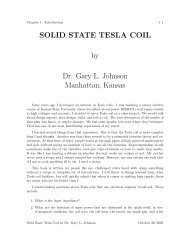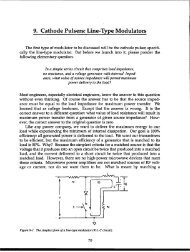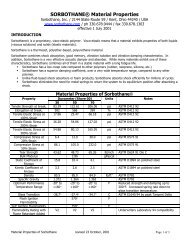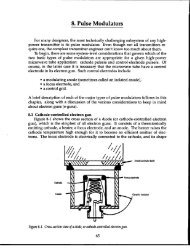3.6M north10.pdf - Dean-O's Toy Box
3.6M north10.pdf - Dean-O's Toy Box
3.6M north10.pdf - Dean-O's Toy Box
Create successful ePaper yourself
Turn your PDF publications into a flip-book with our unique Google optimized e-Paper software.
Cathode Pulsers: Hard-Tube Modulators (10) 189<br />
I<br />
1<br />
Crossatron tubes have been built withas much as 100 kV hold-off and closing<br />
currents as great as 12,000 A. When optimized as either a closing-only or opening-only<br />
switch, the 8454H is rated at 50-kV hold-off, 2500-A closing, and 1OOO-A<br />
opening. The Crossatron is one of the few full-control (or at least self-commutation)<br />
switches that is still in the process of being developed.<br />
10.5 Load lines<br />
Although we have discussed and illustrated the voltage/current characteristics<br />
of a number of triode and tetrode modulator switch tubes, we have yet to<br />
relate them to the complementary aspects of the non-linear load impedances that<br />
they will be expected to drive. Figure 10-30 shows how two types of modulators<br />
would interact with three types of loads, described as load lines. In this representation,<br />
load voltage/current relationships are plotted starting with the 0/0<br />
points of the voltage/current axes. The modulator, or source, voltage/current<br />
relationships are plotted backwards, starting at the open-circuit-voltage, zerocurrent<br />
points.<br />
Of the three load characteristics, only one represents an actual device. (It is<br />
also the least linear one.) It is a backward-wave, crossed-field amplifier, the QK-<br />
622 Arnplitron. As voltage is increased across the QK-622, current builds up<br />
slowly, reaching only 4 A at 40 kV, which is near the knee of its characteristic.<br />
Between 40 kV and its operating voltage of 50 kV, current dramatically increases,<br />
from 4 A to 32A. At its operating point, its equivalent linear-resistance impedance,<br />
its second characteristic, would be 1563 ohms, which is the slope of a<br />
straight line from the operating point back to the origin. However, its dynamic,<br />
or incremental, impedance is the slope of the characteristic, or AV/N, as it passes<br />
through the operating point, which is 200 ohms, not 1563 ohms. The third load<br />
characteristic illustrates is a hypothetical linear-beam device whose operating<br />
point is the same as the QK-622 Arnplitron, and it follows the 3/2-power voltagecurrent<br />
relationship. Its incremental impedance at the operating point would be<br />
AV/A.I,or 1024 ohms.<br />
Also shown are the source characteristics for two types of pulse modulators:<br />
line-type and hard-tube. The line-type modulator characteristic starts at 100 kV<br />
and zero current at the right side of the graph and ends at zero voltage and 64A<br />
at the left side, passing through its matched-load operating point of 50 kV and 32<br />
A. The open-circuit voltage is twice the matched-load voltage and the shortcircuit<br />
current is twice the matched-load current, which is a sure-fire criterion for<br />
recognizing a matched source. (It is not, however, matched to the incremental<br />
impedance of either of our microwave-tube loads.) The hard-tube modulator<br />
characteristic starts at 60 kV and zero current at the right side. It is discontinuous,<br />
however, having a knee. In fact, it is much like the Amplitron characteristic only<br />
rotated by 90°. This means that the hard-tube modulator is the Arnplitron’s dual.<br />
As the voltage drop across the hard-tube switch increases beyond the knee, which<br />
occurs at 50 kV (10-kV tube drop, working from right to left), the current tends to<br />
be essentially constant, which is the exact opposite of what happened to the<br />
Arnplitron. Therefore, the hard-tube switch has two distinct incremental impedances:<br />
one relatively low “below the knee” and another relatively high “above<br />
the knee.” The most dramatic difference between the two was exhibited by the







